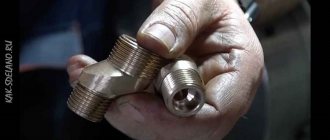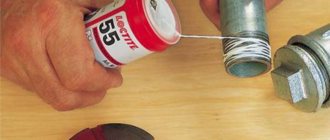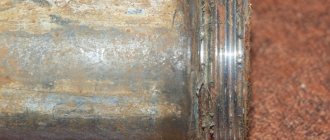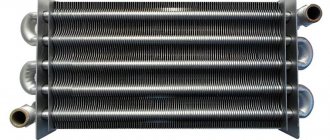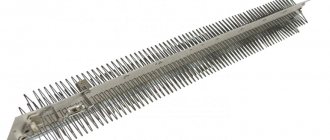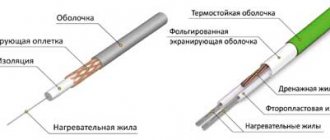A great variety of sealants for connecting pipes have appeared. Threads or joints are covered with whatever they can, and every master praises what he likes. We have collected for you the main types of sealants and invite you to figure out in which cases which sealant is best to use for sealing threaded connections.
Main types of pipe seals
From the entire arsenal, the following can be distinguished:
The question “which pipe sealant is better and which is worse?” - incorrect. In order to understand this question, it needs to be posed somewhat differently: “What type of sealing of threaded connections should be used in specific conditions?”
Let's start with what sealant should not be used for threaded connections:
- Silicone (good for flange connections);
- Ship's red lead;
- Whitewash, various types of paints.
So, there are 4 types of material left:
A little history
The material from which the tape is made was accidentally discovered by American engineer Roy J. Plunkett in 1938, while working for DuPont. It was registered under the Teflon trademark.
By 1948, more than 900 tons of fluoroplastic were produced. It was used at a uranium enrichment plant to insulate valves and joints in pipes. In 1954 they began to use it “for peaceful purposes.” The first Teflon-coated pans appeared (Tefal brand).
And in 1969, Robert Gore joined the research. He worked for W. L. Gore & Associates, owned by his father. The company received an order to create a new composition for plumbing purposes. Experiments began.
It took Robert a long time to make a thin elastic tape from a PTFE bundle - it broke. But Gore Jr. did not give up. He stretched the tourniquet in various ways. One of them (stretching with a jerk) gave an unexpected result. PTFE expanded 8 times to form a finely porous structure consisting of 70% air.
Thanks to this invention, not only FUM appeared in our lives, but also waterproof fabrics for clothing, sports shoes, medical implants and waterproof laminate.
Seal flax
Flax for winding threaded connections
You can use flax as a winding for pipes on all metal parts: brass, cast iron, steel. With limitations, flax can be used where metal threads are soldered into plastic threads. A bad option would be to use linen on completely plastic parts. When sealing threaded connections where the sealant is flax, a large tightening torque is required. This moment can sometimes exceed the capabilities of plastic parts, which is why it is possible to break the thread itself.
Plumbing thread
Sealing threads with plumbing thread
Plumbing thread is an excellent winding material for pipes with one drawback: its high price. It cannot be torn by hand and is suitable for sealing all threaded joints (even those that have a torn surface from a bad thread cutting tool). As for plastic parts, the tightening torque required when using threads is not the same as when using flax. Plumbing thread can be used for all parts.
Sealing paste
Paste is the easiest way to seal threads. A special hardening or non-hardening paste made from synthetic resins with oils and other fillers.
Application of sealing paste
The sealing paste is used for threaded connections of water and gas pipelines , for systems with a non-aggressive environment .
Characteristics of sealing paste
Divided into hardening and non-hardening paste.
Hardening paste
- Withstands temperatures up to 210°C without sanitary flax, and up to 140°C with the use of flax.
- Pressure for gaseous phases up to 20 atm and up to 100 atm for water . The listed characteristics begin to operate after complete hardening. The time for complete hardening ranges from several minutes to several hours, depending on the manufacturer and the ambient temperature.
- Maximum pipe diameter 3 inches.
Non-hardening paste
- Suitable for use in lines with low pressure of liquids and gases.
- Not used for systems with aggressive environments .
- Shows the greatest effectiveness in combination with tow .
- Withstands up to 135°C.
Advantages of sealing paste
For hardening paste:
- High-quality seals the connection.
- Easy to use.
- Can be used for high pressure systems .
For non-hardening paste:
- Easy to use.
- Protects the joint from corrosion
- Possibility to easily dismantle the connection.
- Immediately after installation it is ready for use.
Disadvantages of sealing paste
For hardening paste:
- shrinks after drying .
- Once cured there is no possibility of adjustment.
For non-hardening paste:
- Cannot be used in aggressive environments.
- Suitable for systems with low pressure or no pressure at all.
How to use sealing paste
Before using sealant, the threads should be degreased and dried . Apply the paste evenly to both parts of the connection and mount immediately (this is especially true for hardening paste). For non-hardening paste, it is possible to use tow.
Manufacturers of sealing paste
- Russia MasterProf . Russian manufacturer of seals.
- Europe Unipak. A very popular company producing various types of seals.
- China Viscotex . Chinese company producing sealing paste.
Anaerobic sealant
Anaerobic sealant is certainly suitable for sealing all plastic threaded connections, for brass, for cast iron, factory-made, but there is one peculiarity on steel parts.
When threads are made in a steel part, various types of lubricants are used that get onto the threads. When applying glue, once it hits a greasy area, it lingers there. This may not be noticed. Once the coupling begins to be turned, a channel may form through which the liquid will then flow out.
It is not always possible on site to remove grease from the surface of the thread. Therefore, it is not recommended to use glue-sealant as a sealant for steel threads and parts, since there is flax and thread.
When using sealant, pay attention to what kind of adhesive sealant you got. Some grades require heating when disassembling the joint. Imagine a metal connection with a metal coupling followed by a plastic pipe. To disassemble it, you must first heat it up (obviously more than 100 degrees). For the metal part this does not matter, but the plastic pipe may later be damaged. Therefore, look at what type of threaded connections you seal with sealant!
Where is it used?
Due to its properties and characteristics, FUM tape is used in most situations where sealing treatment is required.
- Water pipes . The most important thing that FUM tape is used for is sealing water connections. The material is water-repellent, which makes it almost indispensable for fastening water pipes and parts during the assembly and installation of equipment.
- Gas pipeline . The film can be made gas-tight, and it can be used to install gas appliances and meters. However, not every FUM tape is suitable for this purpose; you need to purchase a specialized tape for gas.
- Technique . The material is characterized by resistance to various types of influences, therefore it is actively used to repair internal mechanisms of cars and various technical devices.
Heating pipes fastened with tape Source re-st.ru
How to seal a joint with flax?
When sealing threaded connections, you need to be very careful. Accuracy is the key to ensuring that nothing leaks. When working, you will need a special paste, which you cannot do without. It can be applied to the thread immediately or to already wound flax.
Paste gets your hands dirty. It's not very pleasant to wipe them off. Therefore, there is a life hack - the installer first sits down, winds flax onto a threaded connection, checks the quality of the winding (everything should be smooth) and then uses the paste, making a dozen connections at once. The connection must be free of protruding hairs, the first two turns remain free so that you can safely screw the coupling onto the external thread. And towards the end of the thread a roller or thickening is formed.
All compaction occurs on the last two threads. They are not completely cut through, smaller than the other turns. They are sealed by gluing the sealing material between the two parts.
Disadvantages, negative points
Despite the large number of advantages, natural sealant is not without its disadvantages. They are especially obvious when installation and repair technology is violated. After short-term use, rust may form at the joints, making it difficult to dismantle structures during subsequent repairs. In view of this, it is recommended to regularly inspect connections for leaks and take measures to eliminate damage.
The material is very sensitive to the quality of work, so it is recommended to use it only by experienced craftsmen.
Attractive physical properties are compensated by the low chemical sensitivity of the material. Thus, flax fibers will be destroyed under the influence of antifreeze if they are part of the mixture passing through connected communications.
How to apply adhesive sealant?
It is impossible to apply sealant to many joints at once, as with flax. The glue is applied to the thread immediately before the “sausage” connection, which is then well spread over the entire thread. This is necessary to prevent empty spaces from appearing through which water can then seep through.
The threads should be checked after sealing the connection. Therefore, sealant is used quite rarely, in the most necessary cases. For example, when you need to connect a plastic part with a metal one, you can’t think of anything better than glue.
The manufacturer recommends applying sealant to only one part, but experience says otherwise. If you are sealing a threaded connection that will be difficult to get to, then apply the glue well with your finger to the coupling and threads so that there are no unpainted areas anywhere. It has a blue or red color, it is clearly visible. It is necessary that all the streams are filled and then the parts can be connected. For steel parts, it is better not to use glue as a sealant for pipes.
If you are a professional, then you must have 3 types of pipe seals in your suitcase:
If you are not a professional and want to do something for yourself, then you will have a choice between flax and thread. Most likely you won't need any glue at all. You can practice with flax or thread if you don't want to spend a lot of time and effort.
Rewinding threaded connections using flax
Today, the problem of winding threaded connections has become urgent. In our stores we see different materials and methods of winding. How to understand this and find your own way of affordable and reliable winding (sealing) of fittings? Let's talk about this.
On display the following are presented as winding materials: Lena Fum, special thread, sealants and more. But in our work, for 18 years now, we have been using regular good quality flax and special paste for flax to wind threaded connections. Linen is simple, reliable and inexpensive.
Now there is a fashionable trend to fill heating systems, for example, with a special coolant based on antifreeze. Therefore, if you do not use flax as a winding for threaded connections, then you may end up with additional work draining the system and repacking the fittings. As with all rules, working with flax has its own nuances and secrets.
Specifications
Let's consider the technical characteristics of the FUM tape, which determine its properties:
- the material is characterized by resistance to damage;
- has plasticity;
- retains its properties for a long time and does not need regular replacement;
- is environmentally friendly and does not emit harmful substances;
- heat-resistant, able to withstand a wide range of temperatures;
- the thickness is only two tenths of a millimeter;
- has dielectric properties and gas impermeability;
- elastic, capable of stretching almost twice its original length.
Sealing of threaded connections
Sealing of threaded connections
Every person who independently replaces plumbing in an apartment or house sooner or later faces such an important point as the correct sealing of threaded connections. After all, even the eccentrics of the mixer, even those, need to be packed. In any average apartment, you can count at least 15 threaded connections that require sealing (often there are much more such connections). Therefore, we invite you to master such a necessary, and at the same time, simple skill as sealing (packing) threaded connections of pipes and fittings.
The first, quite reasonable question that a beginner asks is: “What should I pack?” After all, the modern market provides different materials and sealants, and it is not easy to decide and choose the one, the only, best material for sealing. Many experts are skeptical about tow (flax), which has been used for centuries to seal threaded pipe joints, giving preference to fum tape, which looks very neat and is, at first glance, easier to work with. And most people associate tow with a sloppily wrapped and painted connection “a la a housing office plumber.”
tap for radiator or heated towel rail
In fact, everything is not like that. Most experienced specialists pack with tow (linen), since such a connection is more reliable than sealing with fum tape. And if for threaded connections packed on linen it is possible to make adjustments with return (partial unwinding), then for pipes packed on fuma such a maneuver is practically impossible, since this will break the seal and you will have to repack the connection again. With a certain skill, a connection packed in tow can be made neat, so that even its individual turns will not come out, leaving the appearance of such threaded connections absolutely unchanged. As for paint, it has long been replaced by all kinds of sealants, the advantages of which are not only reliable sealing of threaded elements, but also facilitating sliding when assembling and disassembling threaded connections. Examples of such sealants are UNIPAK and GREENPASTA. Let's look at an example of how threaded connections on tow (linen) are sealed: Any threaded connection has an external thread and an internal one. A fitting with an external thread is lubricated with sealant, and a thin bundle of flax is carefully placed along the thread, in the direction of rotation, into the grooves of the thread. In order to ensure that when twisting the connection, the flax (tow) does not “slip” or slide off the thread, you must first make several diagonal turns in relation to the thread, and then, on top of them, carefully place the tow in the groove of the thread. An excess of tow is just as harmful as a lack of it, since the excess tow will be cut off when twisting the joining elements, and what is most offensive, will take with it most of the “useful” tow. Therefore, we strongly recommend: “Don’t overdo it!” In order for the connection to have a beautiful aesthetic appearance, wind the tow only on the thread. After winding the tow, lubricate it again with sealant, after which the connection can be twisted. Excess tow, which can get out of the joint, is carefully removed with a sharp knife. If you follow all the recommendations, the connection will be reliable and accurate. You check the connection at maximum system pressure, and if it doesn’t leak, then it definitely won’t leak. If it oozes very weakly, it is possible that it will linger later, because tow has such a wonderful property - to swell when wet. But it’s best to repack the dripping compound: You’ll sleep better and gain experience.
What is the best way to wrap a threaded connection on a heating system? — Household Forum — Ulanovka.Ru
What is the best way to wrap a threaded connection on a heating system? — Household Forum — Ulanovka.Ru — The largest forum in Buryatia
On sale you can find many different materials that are designed to seal pipeline joints. The question arises: which material should be used in which cases? And also, how to properly use this or that seal?
It is often possible to use two or more thread sealants at once; then clarification is required as to which to prefer. The recommendations given should help to understand these issues and find a solution that will ensure sufficient reliability of the connection of pipes and threaded fittings for the entire period of operation.
Linen winding
Flax is a cheap material for threaded joints that creates a very high-quality seal. The only thing is that it cannot be used in all cases.
It is intended for connecting metal parts, as it creates significant density. It is very durable; the force applied by the keys to the two parts being connected is required to be significant.
Therefore, flax is not compacted:
- plastic parts - the tightening torque exceeds the strength of the material, the parts will be crushed and destroyed, at least the threads.
- parts in which a metal coupling with a thread is embedded in a plastic (polypropylene) shell, due to the danger of rotation (disconnection).
For all metal products, flax is the No. 1 material for winding threaded joints.
Next, let's look at how to apply it correctly. Flax cannot be used “dry”; it must be lubricated with a special plumbing paste. It is applied either directly to the thread or to wound flax.
People's experience also suggests that sunflower oil can be used instead of paste, but the quality of the joint does not decrease, at least there is no such information.
A strand is separated from the flax and wound along a thread along each stream. Winding is done tightly and neatly. There should be no protruding hairs. The first two turns are not filled, but a shoulder is made at the end of the thread.
Special plumbing thread
A special thread for seals, of high strength (cannot be torn by hand), wound on spools, is sold in stores. Its main drawback is its high price, but otherwise it has solid advantages.
- It can be used on any parts, the tightening torque is less compared to flax, so you can also wrap plastic.
- It seals very well and can be used even on torn threads.
If it were not for the cost of this material, then only such plumbing thread would be used for joints.
Winding is carried out in exactly the same way as with flax - the first two turns of the thread are left empty so that the parts can be joined, and then winding is carried out along each thread of the thread, at the end of the winding - a double layer, i.e. shoulder
Fum tape
Fum tape is not suitable for creating reliable connections on pipelines. The material is not very durable; there is no sufficient density in the threaded connections of metal products with it. But for plastic connections that will be dismantled, for example, a summer pipeline for irrigation, fum tape is the most suitable sealant.
With fum tape, the parts to be joined can be wrapped by hand. In this case, a small density of the joint along the thread occurs, so that leaks do not occur for some time. A slight tightening force does not provide sufficient tightness and does not guarantee that the joint will not leak. For fixed connections, especially if they will be inaccessible during operation, it is recommended to use other materials. Heating in the house can be done independently - the main installation issues
If the connection to the fum tape, which is already in operation, is turned, a leak will most likely occur. This is a serious drawback, considering that rotation does not require much effort.
At the household level, fum tape can be used (and is popular due to its low cost, ease of use, and low effort) for connections that are in plain sight - when connecting showers, taps, etc. Which heating scheme is best to use in a private house?
Plumbing adhesive sealant for threaded connections
The material is special, not exactly cheap, seals well, no cases of leakage have been recorded after its correct use. But only after the wrong... The obvious disadvantage of sealant adhesive is that the quality of the joint will depend on the “human factor” more than with windings. The fact is that glue does not work well on oily surfaces.
Where do greasy surfaces come from? It could simply be carelessness - they dropped oil on the thread or rubbed the part in oil with their hands. Parts can be stored in a lubricated state (primarily steel ones). But the main thing is that a lubricant is used when cutting threads. After such an operation on steel parts, glue and sealant are completely unsuitable.
Please note that there are glue samples with which undocking the pipes requires heating of more than 100 degrees. Such heating is often difficult, not safe, plastic can be damaged, etc. Therefore, the adhesive-sealant is still selected according to the circumstances.
The glue is easy to apply. It is applied only immediately before joining, squeezed out of the tube onto the thread and smeared with your finger over the entire thread without skipping.
In what cases should you choose glue?
- When connecting plastic parts to metal ones, glue will be preferable. But such a connection does not occur often.
- The second case is when access to the docking site will be difficult. It is better to place such a connection with glue, and lubrication is carried out generously, without saving, on both parts being joined.
Winding Features
Winding on threads requires great care. The thread must be filled in an even layer without gaps, and there must be sealing material in each groove. It is laid to the end of the thread, where a shoulder is formed from it. The main tightening of threaded connections occurs on the last two threads. On parts, more often than not, the last two turns of the thread are not cut to the full depth. Therefore, in this place the material is wedged between the two parts very tightly.
It would be nice if, when carrying out work, you organize additional (cross-cut) quality control of the flax winding. This is especially true when several dozen similar connections are performed at once.
conclusions
- For those who are constantly engaged in installation, it is recommended to always have flax, plumbing thread and adhesive sealant with you in order to quickly and efficiently complete any connection. It is recommended to apply all this in accordance with the tips given above.
- When doing work at home with your own hands, when doing something simple and in plain sight, you can use cheap fum tape, but you need to wrap more. When installing entire systems with your own hands, it is better to use flax (with vegetable oil) on metal, and for small volumes of work it is even better to use thread. Maximum attention should be paid to the quality of winding on the thread.
What should never be used to seal threaded connections:
- There is no need to use simple silicone; it is designed for flange connections.
- There is no need to use paints, whitewash, or red lead, which are of little use, but make the connections semi-dismountable - this is long outdated.
FUM tape
FUM tape is a sealant made of fluoroplastic. The full name is fluoroplastic sealing material. Used to seal threads of predominantly small diameters , up to 1 inch.
Application of FUM tape
The main purpose of FUM tape is to seal the threads of the water main. Depending on the brand of the paddle, it is used in many other areas of industry. Such as the food industry, pharmaceutical industry.
FUM tape brands
- Brand 1 . The most popular tape among those presented. Used in fixed threaded connections. Suitable for use in aggressive environments with acids and alkalis. Contains up to 20% lubricant .
- Mark 2 . Mainly used for oxygen lines. There is no lubricant , as it can cause a fire if it comes into contact with oxygen.
- Mark 3 . The rarest brand of fumka of all. It is used for industrial pipelines in gas and water supply. Contains no or very small amounts of lubricant.
Yellow FUM tape is used to seal gas pipelines . But despite its main purpose, it is successfully used for sealing water mains, due to its higher density than grade 1.
Characteristics of FUM tape
- Temperature limit from − 60°С to + 300°С.
- Very tear resistant . High-quality tape, depending on the brand and manufacturer, can stretch by 200% .
- Increased elasticity . Allows for tight filling of threads.
- Service life 10 years or more.
- Insoluble in alkalis and solvents.
- Withstands pressure up to 100 atm.
- It has a high slip coefficient , which allows the thread to be tightened more tightly.
Advantages of FUM tape
- Well suited for small diameters .
- Does not decompose when exposed to moisture.
- During operation, keep your hands clean.
- Low cost of the product.
- Easy to install.
- The presence of lubricant provides anti-corrosion protection to the metal.
Disadvantages of FUM tape
- Not suitable for use with large diameters.
- Not suitable for heating systems .
- Does not withstand temperature changes and vibration.
- After installation cannot be loosened without disturbing the tightness of the connection.
- There is no expansion effect.
How to wind FUM tape onto a thread
This is what a thread looks like with a wound FUM tape.
Despite the apparent simplicity of FUM tape, to work with it, still knowledge .
- The thread should be wound along the entire length of the working surface of the thread , from one edge of the thread to the other.
- The direction of the thread must be . For right-hand threads (right-hand threads are twisted clockwise), the nozzle should be wound clockwise.
- Use only a single piece of foam.
- The thread must be free of rust and not damaged.
How much to reel FUM tapes
There is no such thing as an “exact number of turns”. The threads have different diameters and depths, the thread differs in width and thickness, all these parameters directly affect the number of turns.
The tape must cover at least half the depth of the thread. As a rule, this is at least 5-6 turns.
Manufacturers of FUM tape
- Russia . Moment . One of the best Russian manufacturers.
- Europe. VALTEC. Italian fumka, very popular in Russia.
- China. Intertool . Good quality at a good price.
